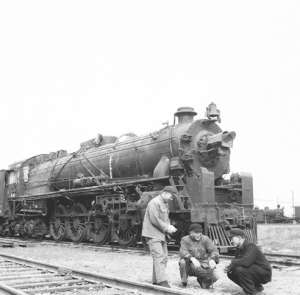China Railways KF
Chinese Government Railways Class KF
 |
| Type and origin |
|---|
| Power type |
Steam |
|---|
| Designer |
Colonel Kenneth Cantlie |
|---|
| Builder |
Vulcan Foundry |
|---|
| Build date |
1935—1936 |
|---|
|
| Specifications |
|---|
| Configuration |
4-8-4 |
|---|
| Gauge |
4 ft 8 1⁄2 in (1,435 mm) |
|---|
| Leading dia. |
900 mm (35.43 in) |
|---|
| Driver dia. |
1,750 mm (68.90 in) |
|---|
| Trailing dia. |
1,050 mm (41.34 in) |
|---|
| Length |
28.410 m (93 ft 3 in) |
|---|
| Adhesive weight |
67.96 tonnes (66.89 long tons; 74.91 short tons) |
|---|
| Total weight |
259.5 tonnes (255.4 long tons; 286.0 short tons) |
|---|
| Fuel type |
Coal (FDP) |
|---|
Firebox:
• Firegrate area |
394.64 m2 (4,247.9 sq ft) |
|---|
| Boiler pressure |
15.5 kgf/cm2 (1.52 MPa; 220 psi) |
|---|
| Cylinders |
Two, outside |
|---|
|
| Performance figures |
|---|
| Maximum speed |
85 km/h (53 mph) |
|---|
| Tractive effort |
193.00 kN (43,390 lbf) |
|---|
|
|
|
The Class KF (聯盟型, 'Confederation class', re-designated "ㄎㄈ" or "KF") was a 4-8-4 mainline passenger steam locomotive type built in the United Kingdom by the Vulcan Foundry for the railways of China. Between 1935 and 1936, 24 locomotives were built for the Guangzhou–Hankou Railway designated as the 600 series. Following World War II, and the establishment of the People's Republic of China, the Chinese Government assumed control of the railway and re-designated the engines in 1954 as the "ㄎㄈ" class ("ㄎㄈ" being the Zhuyin characters for "K(o)-F(o)") from the first two syllables of "Confederation", and in 1959 as the "KF" class.
History
In July 1933, the Guangdong–Hankou Railway was in need of new motive power for their being finished Guangzhou to Shaoguan line (capital of Guangdong Province to the northern border of the province). However, this particular line had been burdened with gradients of around two percent as well as curves with less than 250 m (0.16 mi) radi, and low capacity bridges. This necessitated a locomotive design that had more tractive effort while retaining a low axle load. The railway approached the Vulcan Foundry in Britain, who devised a series of 24 locomotives of a 4-8-4 wheel arrangement.
The engines were a significant improvement over previous designs, incorporating a more efficient E-type superheater and duplex steam valve to allow better steaming without enlarging the boiler. The 4-8-4 wheel arrangement allowed for better weight distribution as well as improved handling on sharp curves.
When the Changsha - Canton Railway was completed in October 1936, the class KF 1 - 24 locomotives were transferred to operate over northern section between Hankow and Changsha on this new main line. During World War II the locomotive was transferred to Guangxi Province through Hunan–Guangxi Railway, free from Japanese occupied zone. After the establishment of the People's Republic of China, the locomotives were repaired and upgraded[1] to use in Shanghai–Nanjing Railway.
Most of the class KF survived the 1937 - 1945 Sino-Japanese war. They retained their old classification and continued in service up to early 1970s.
Builder details:
- KF 1-16 2D2-h2 520x725 1752 Vulcan Foundry 4668 - 4683 / 1935 Renumbered to 'KF' 601 - 616
- KF 17-24 2D2-h2 520x725 1752 Vulcan Foundry 4696 - 4703 / 1936 Renumbered to 'KF' 617 - 624
Preservation
Two examples are known to have been preserved. One was presented by the Chinese Government to the National Railway Museum, England.[2] Another KF class locomotive is preserved at the Beijing Railway Museum, China.[3]
References
External links
Locomotives of China |
|---|
|
| Steam | |
|---|
|
| Diesel | Diesel hydraulic | |
|---|
| Diesel electric | |
|---|
|
|---|
|
| Electric | |
|---|
|
|

